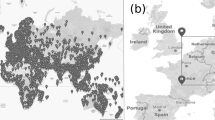Abstract
We study message transfer in a 2-d communication network of regular nodes and randomly distributed hubs. We study both single message transfer and multiple message transfer on the lattice. The average travel time for single messages travelling between source and target pairs of fixed separations shows q-exponential behaviour as a function of hub density with a characteristic power-law tail, indicating a rapid drop in the average travel time as a function of hub density. This power-law tail arises as a consequence of the log-normal distribution of travel times seen at high hub densities. When many messages travel on the lattice, a congestion-decongestion transition can be seen. The waiting times of messages in the congested phase show a Gaussian distribution, whereas the decongested phase shows a log-normal distribution. Thus the waiting time distributions carry the signature of congested or decongested behaviour.
Similar content being viewed by others
References
B Tadic and G Rodjers, Advances in Complex Systems 5, 445 (2002)
B Tadic and S Thurner, Physica A332, 566 (2004)
A Arenas, A Diaz-Guilera and R Guimera, Phys. Rev. Lett. 86, 3196 (2001)
M Rosvall and K Sneppen, Phys. Rev. Lett. 91, 178701 (2003)
M Rosvall, P Minhaggen and K Sneppen, Phys. Rev. E71, 066111 (2005)
W-X Wang, B-H Wang, C-Y Yin, Y-B Xie and T Zhou, Phys. Rev. E73, 026111 (2006)
R Albert and A Barabasi, Rev. Mod. Phys. 74, 47 (2002)
M E J Newman, SIAM Rev. 45, 167 (2003)
C-M Ghim, E Oh, K-I Goh, B Kahng and D Kim, Euro. Phys. J. B38, 193 (2004)
S Mukherjee and N Gupte, Phys. Rev. E77, 036121 (2008)
D Sornette, Critical phenomena in natural sciences (Springer-Verlag, 2000)
B K Singh and N Gupte, Phys. Rev. E71, 055103(R) (2005)
B K Singh and N Gupte, Euro. Phys. J. B50, 227 (2006)
As observed in figure 5a, the standard deviation is quite large as compared to that in figure 5b. This is due to the fact that for low hub density (0.5% as in figure 5a) messages get trapped leading to large fluctuations. The fluctuations are reduced once the messages get cleared for higher hub density (4.0% as in figure 5b)
H Jeong, S P Mason, Z N Oltvai and A L Barabasi, Nature (London) 411, 41 (2001)
H Jeong, B Tombor, R Albert, Z N Oltvai and A L Barabasi, Nature (London) 407, 651 (2000)
C Mayer and T Sinai, The American Economic Review 93(4), 1194 (2003)
Author information
Authors and Affiliations
Corresponding author
Rights and permissions
About this article
Cite this article
Mukherjee, S., Gupte, N. Message transfer in a communication network. Pramana - J Phys 70, 1109–1116 (2008). https://doi.org/10.1007/s12043-008-0115-z
Published:
Issue Date:
DOI: https://doi.org/10.1007/s12043-008-0115-z




